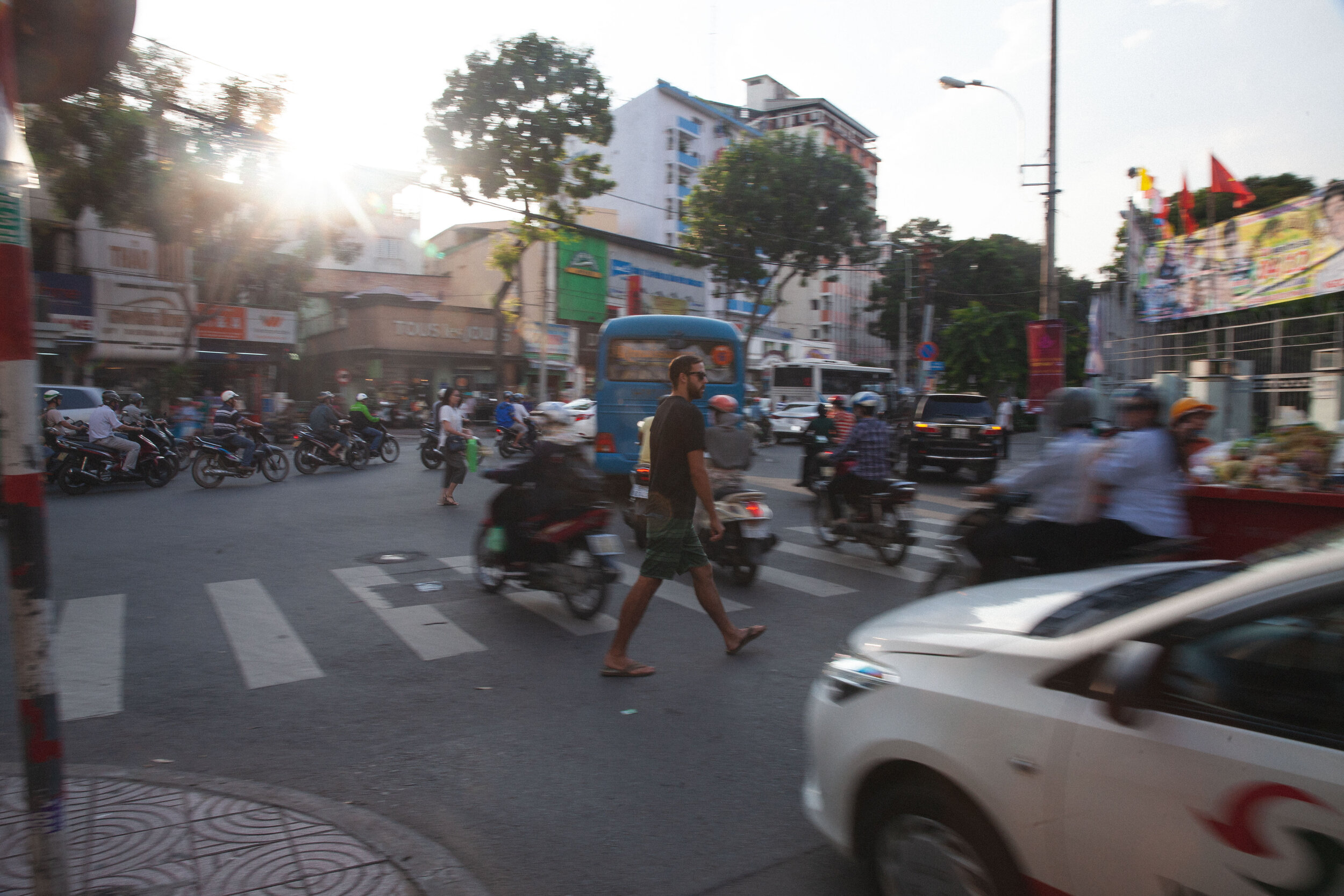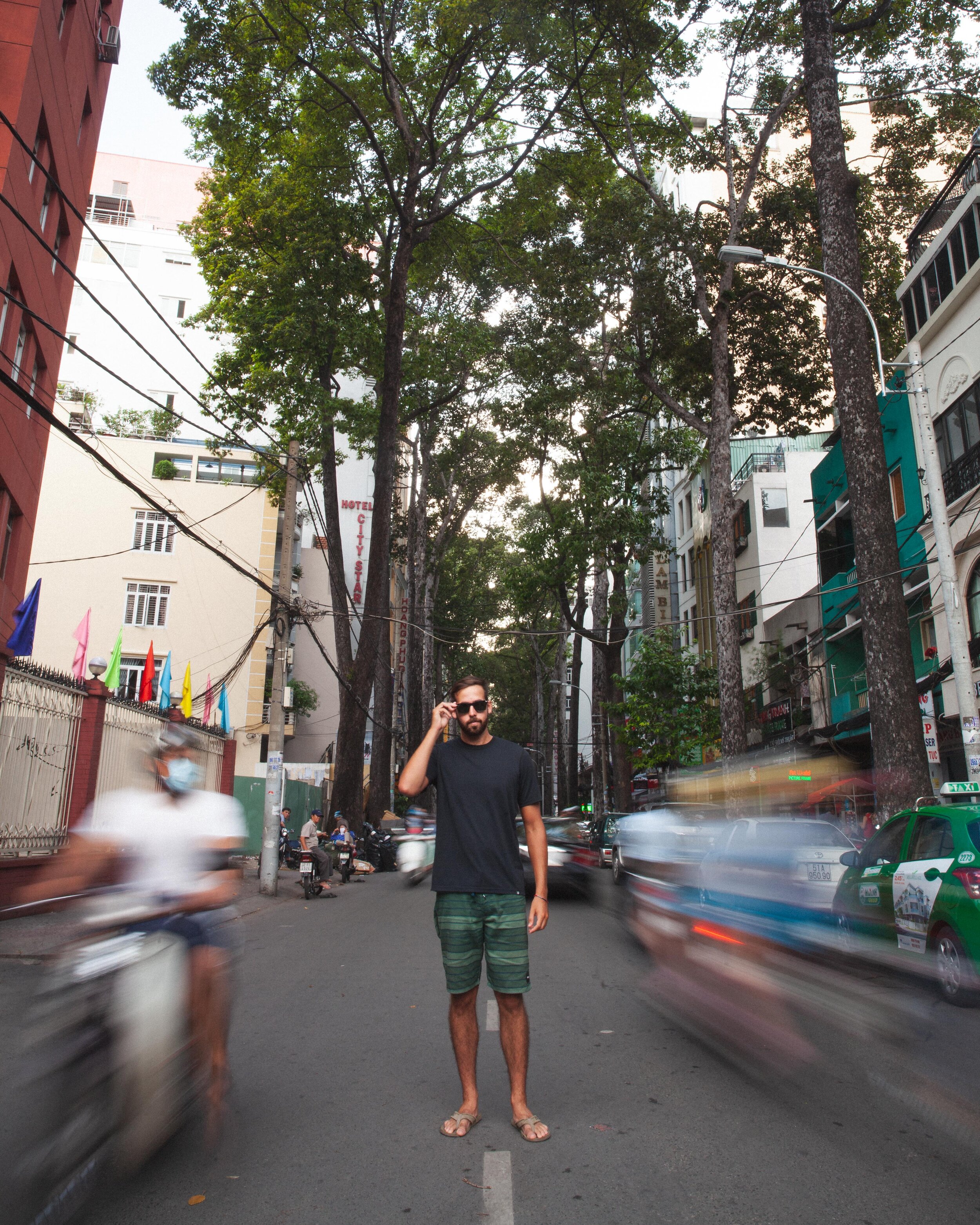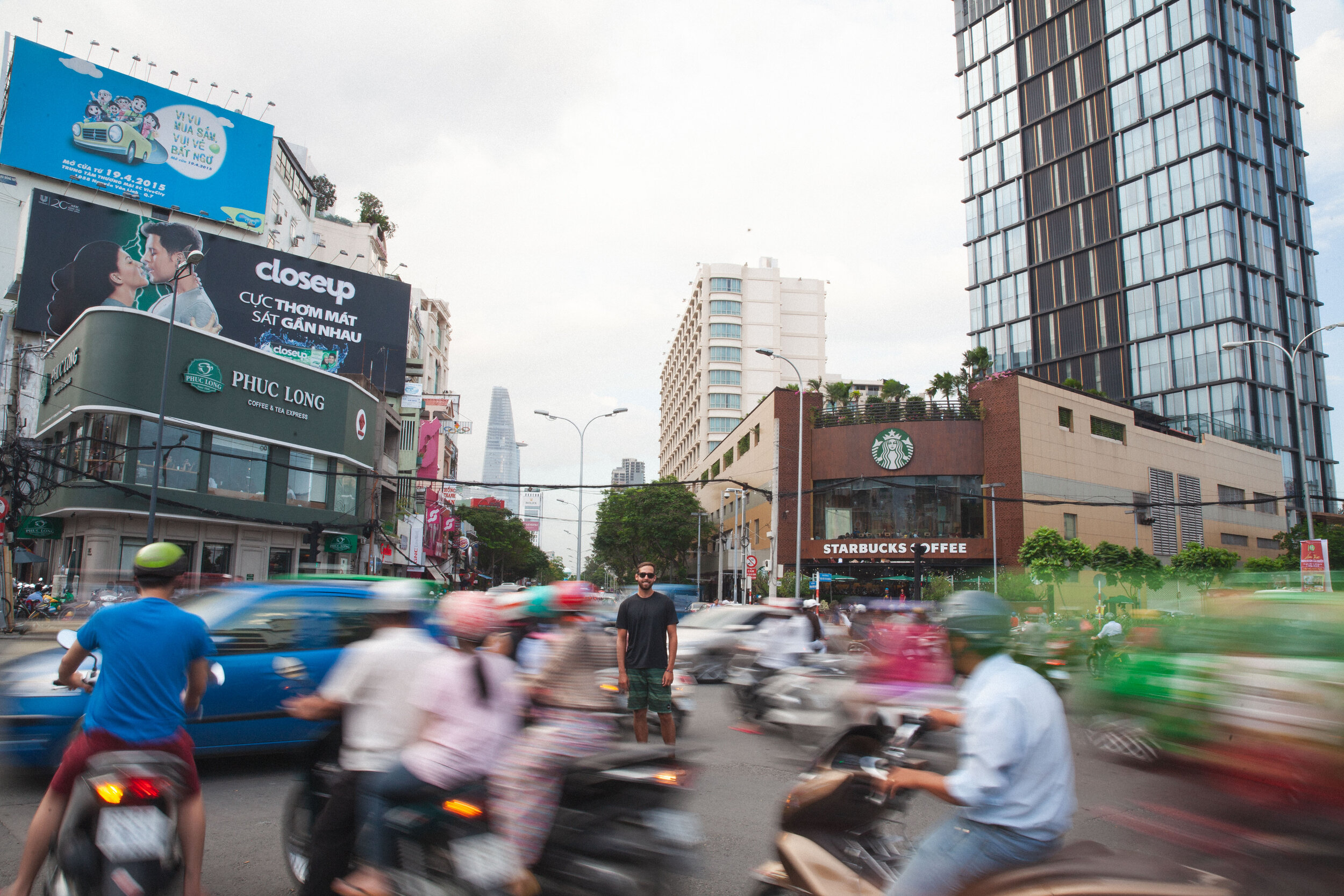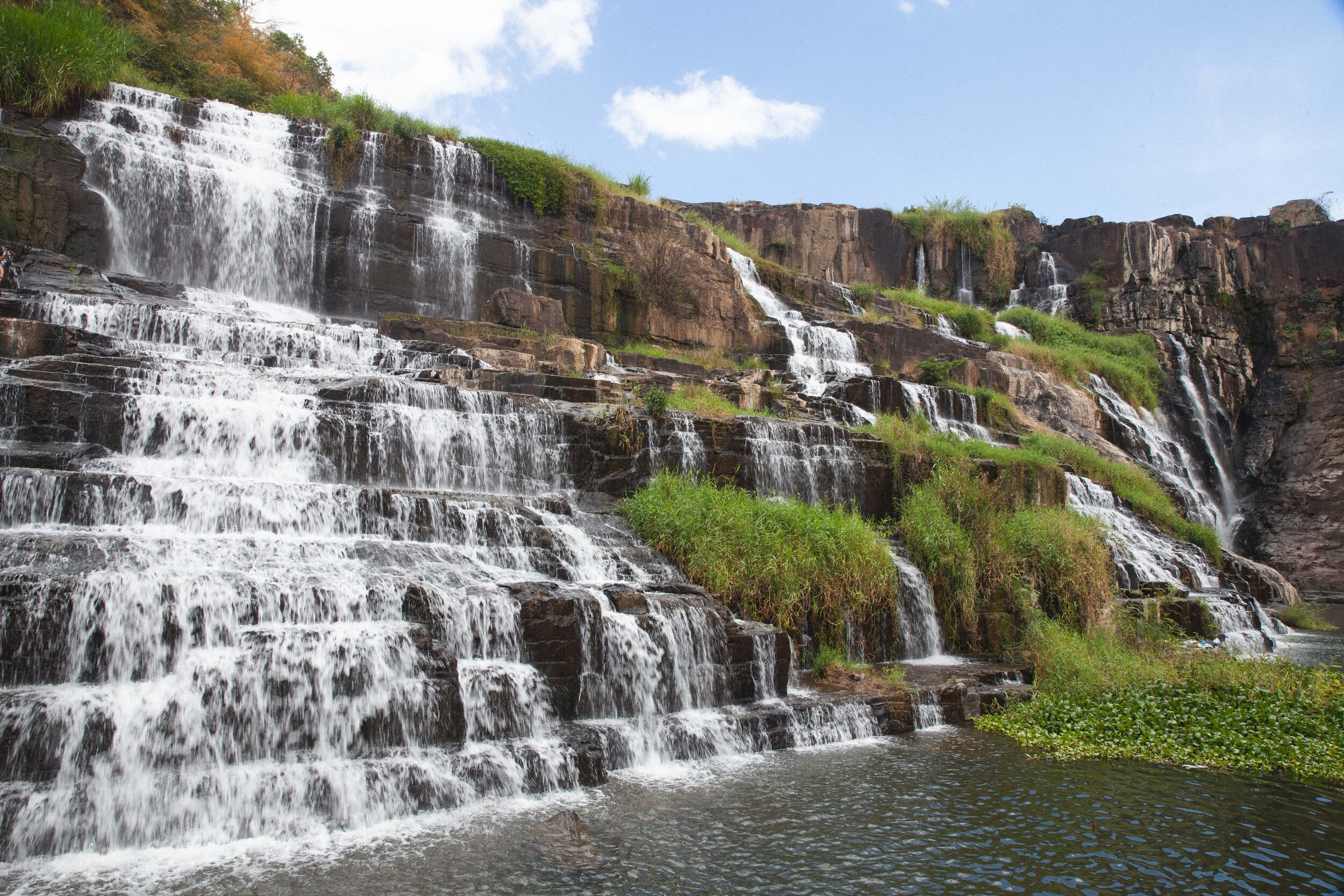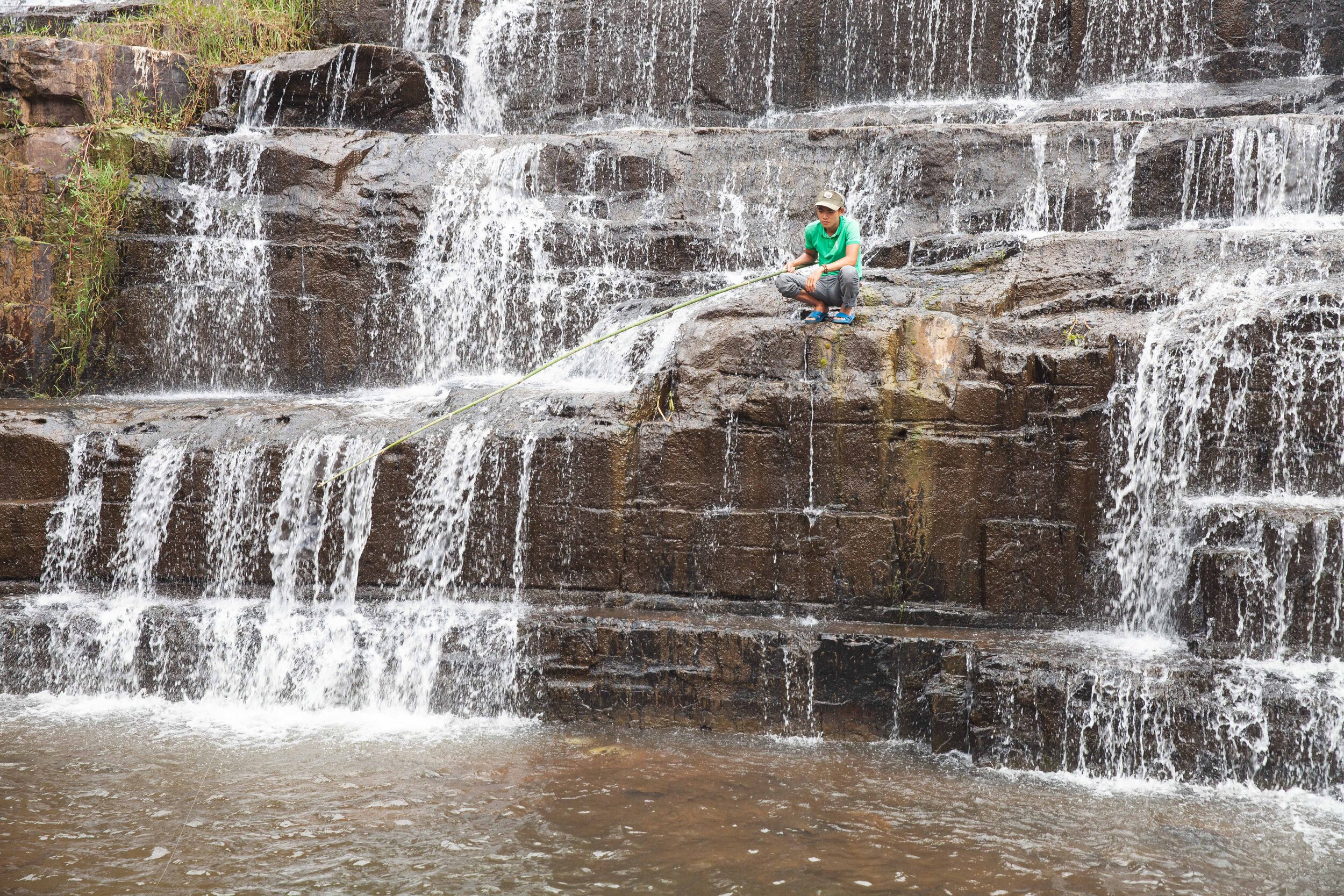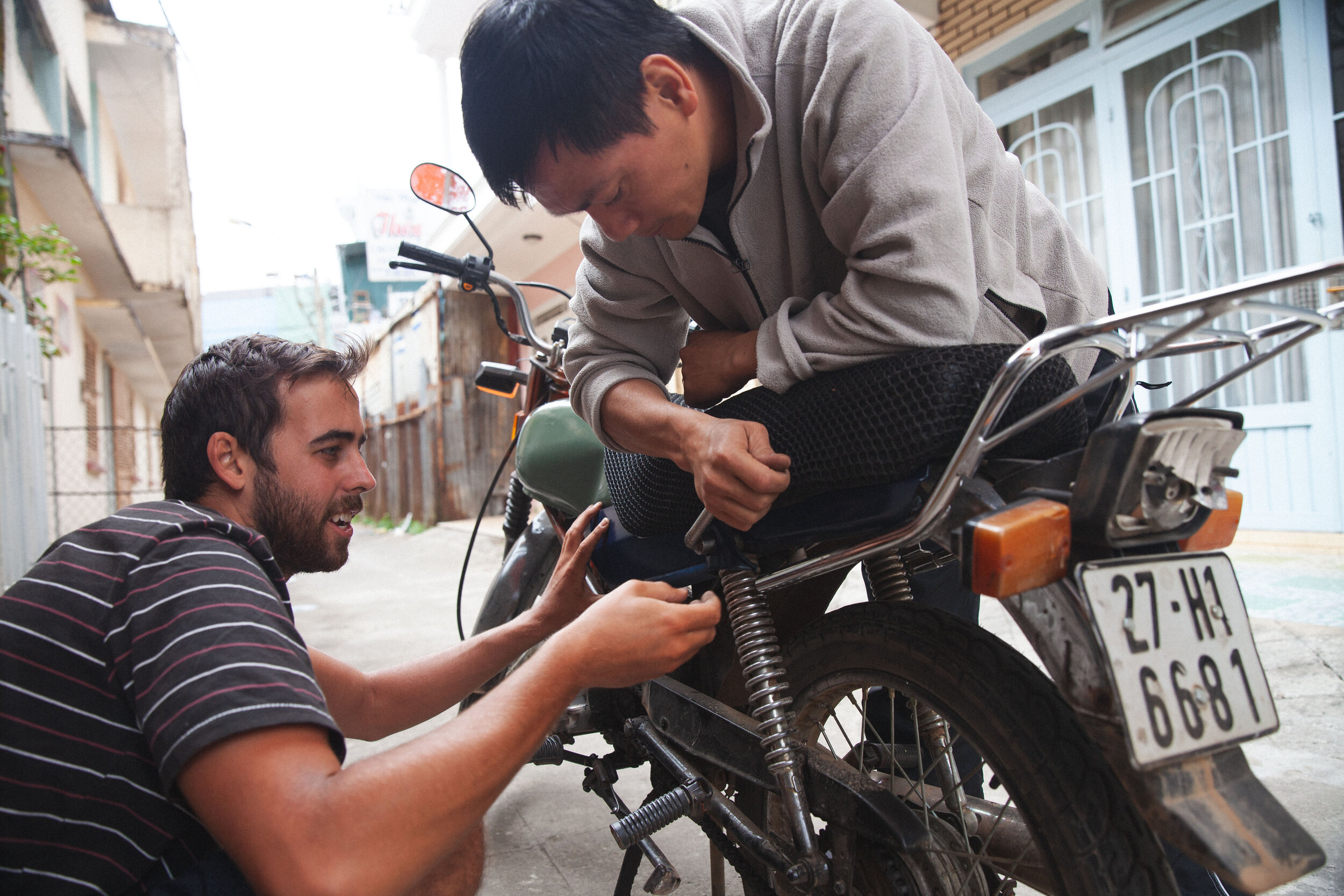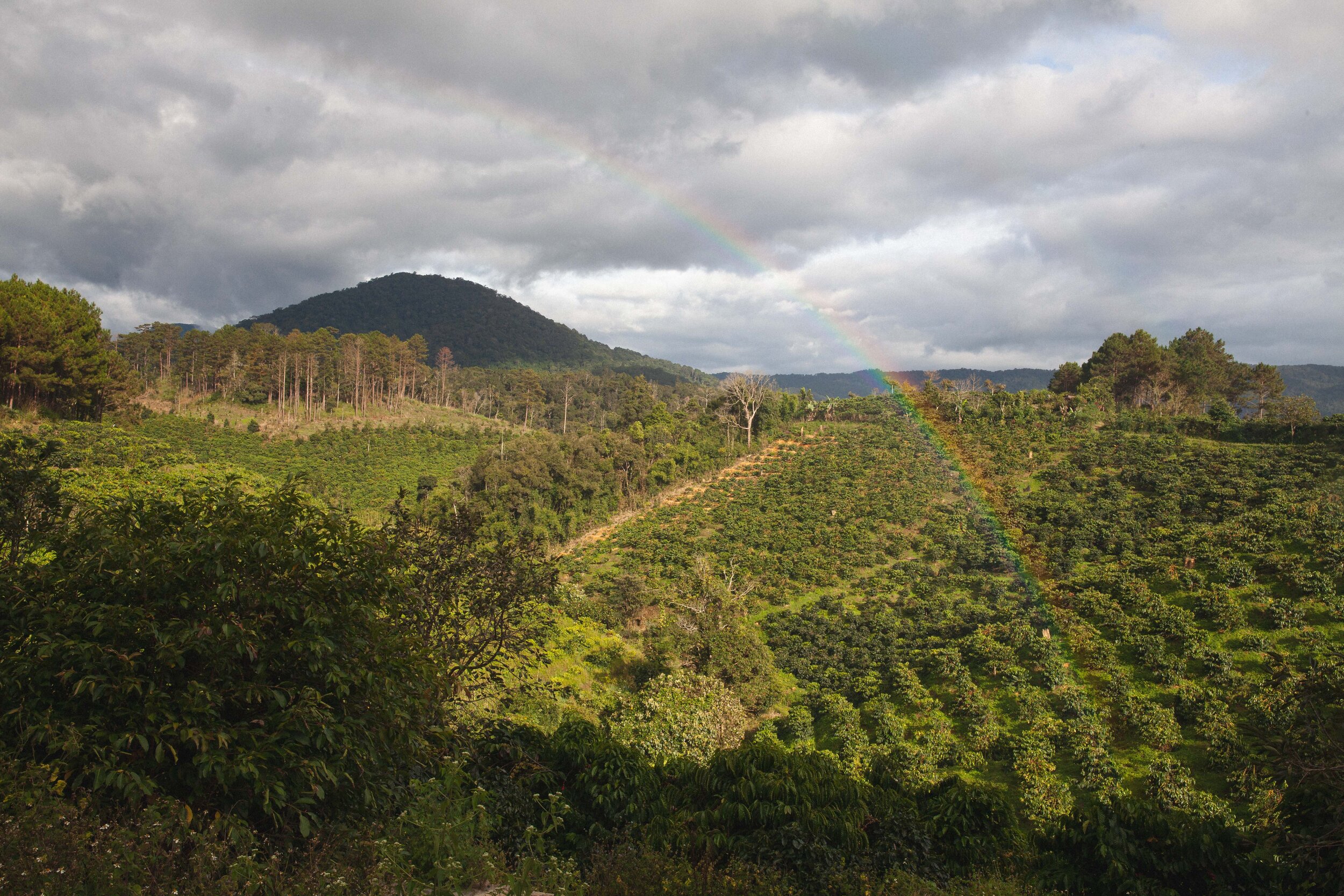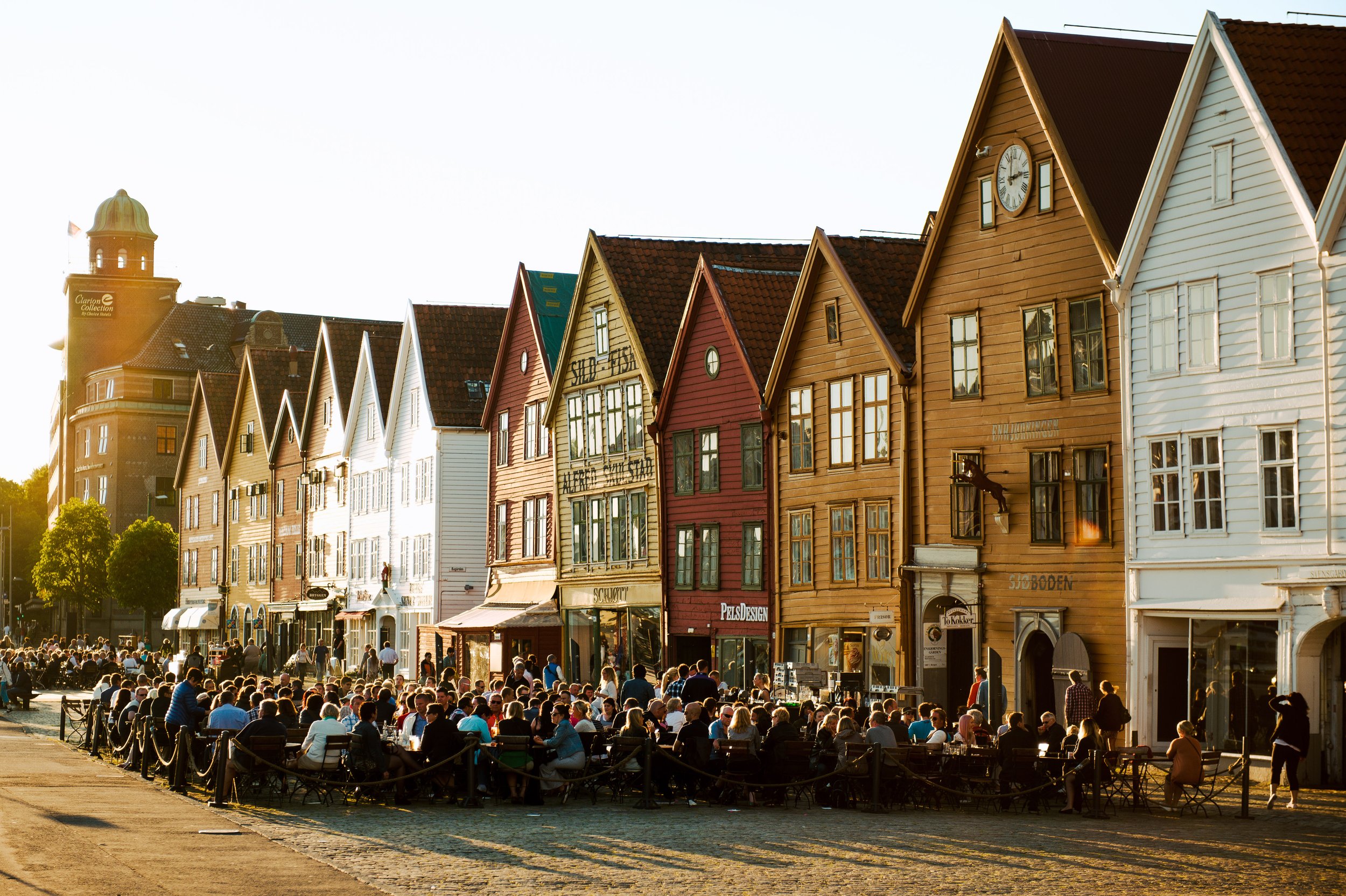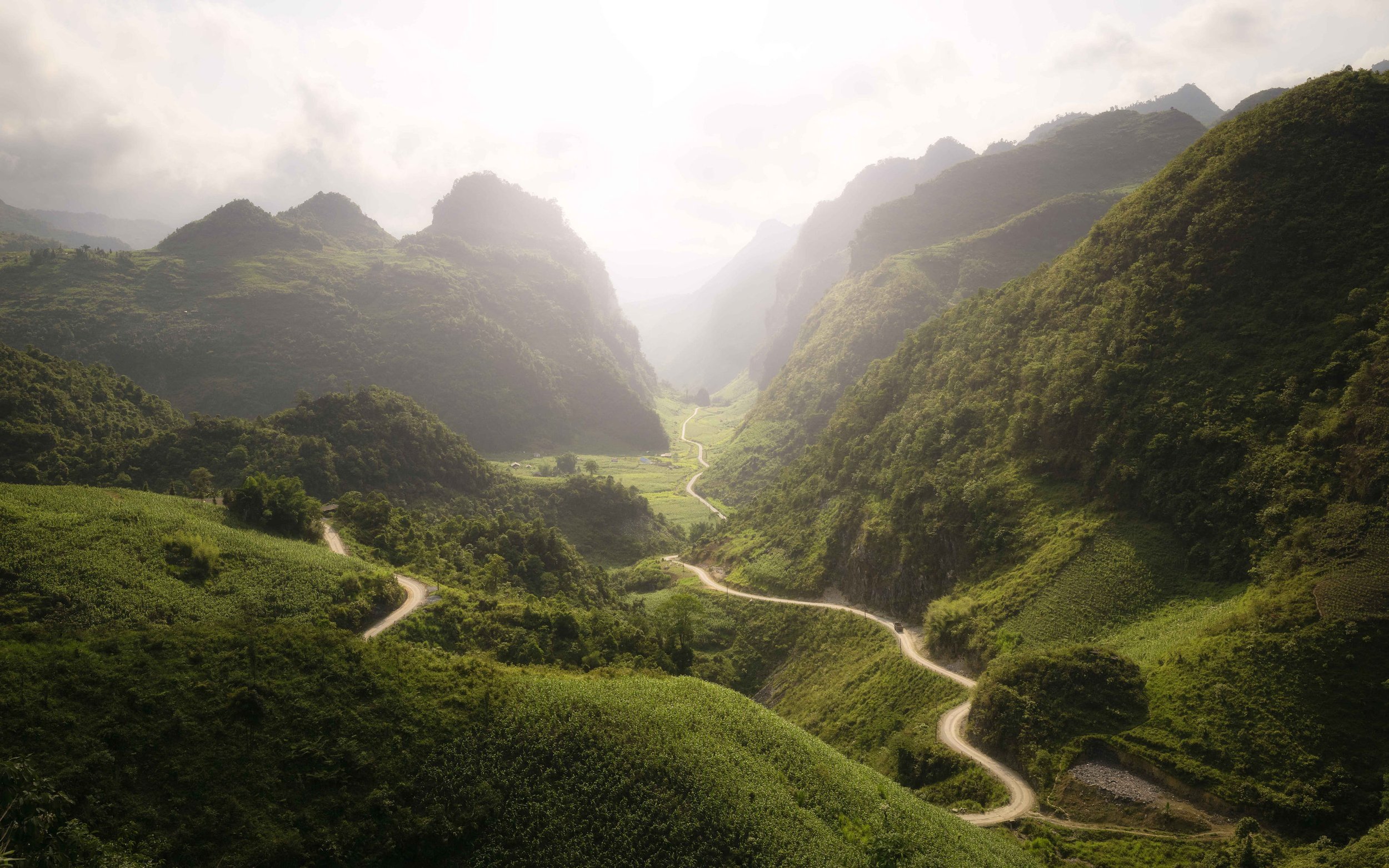Vietnam on Two Wheels

The allure of driving a 70’s era motorbike across the entirety of Vietnam
By Joseph Gulizia (IG)
A month of riding scooters around Thailand left me wondering, “Where could I go next?” The entirety of Southeast Asia was a possibility, but one afternoon in the hostel lounge, staring at maps, it hit me.
“Vietnam, all of it.”
Después de un mes de andar en scooters por Tailandia me había dejado preguntándome "¿a dónde podría ir ahora? Todo el sudeste asiático era una posibilidad, pero una tarde en el salón del albergue mirando los mapas me di cuenta y dije:
"Vietnam, todo eso".
First, we need motorcycles. Following the recommendation of a friend, we set off for Hanoi and a hostel popular with motorcyclists who are beginning or ending their adventure. It’s also a spot to list or buy well-worn bikes, frequently advertised on Facebook, for anywhere from $300-$500.
These aret not shiny Korean, Japanese, or Western bikes, but cheap Chinese knockoffs rebranded the “Honda Win”. These ubiquitous bikes are neither Honda, nor a Win, but copycat “Sufats,” whose builds are as reliable as their odometer.
We take comfort in the routine of once-every-three-day visits to the mechanic. They are perfect.
Primero necesitábamos nuestras motocicletas. Siguiendo la recomendación de un amigo, partimos hacia Hanoi y un albergue popular entre los motociclistas que iban y venían al principio o al final de su aventura, respectivamente, comprando y vendiendo sus bicicletas gastadas, con frecuencia en Facebook, por entre $ 300. - $ 500.
Estas no eran motos coreanas, japonesas u occidentales relucientes, sino imitaciones chinas baratas rebautizadas como "Honda Win". Estas omnipresentes bicicletas no son Honda ni Win, sino "Sufats" imitadores, con construcciones tan confiables como su odómetro.
Nos consolamos con la rutina de las visitas al mecánico una vez cada tres días. Fueron perfectos.
We set out into the Vietnamese traffic, where wave after relentless wave of motorbikes and scooters swarm and criss-cross with little discernable pattern, and pedestrians fearlessly march across roads and roundabouts.
We grit our teeth and focus on adjusting to our bike’s manual transmission, and forcing the fear down deep, we make our way out of town.
Salimos al tráfico vietnamita. Ola tras ola implacable de miles de motocicletas y scooters que se entrecruzan con un patrón poco discernible mientras los peatones marchan sin miedo por carreteras y rotondas.
Apretamos los dientes y nos enfocamos en ajustarnos a la transmisión manual de nuestra bicicleta, y forzar el miedo profundamente mientras salimos de la ciudad.
We decide to follow the 1,700-kilometer Ho Chi Minh Trail from Hanoi to Ho Chi Minh, taking about 3 weeks while avoiding the major AH1 highway. This gives us plenty of time to enjoy the country and then resell the bikes at the end of our journey.
Leaving the city we are greeted by towering mountains, verdant jungle, and the wide open countryside. It is rare for us to cross paths with another vehicle, and even the villages are infrequent.
Decidimos seguir el sendero Ho Chi Minh de 1.700 km de Hanoi a Ho Chi Minh, lo que nos llevó alrededor de 3 semanas evitando la autopista principal AH1. Esto nos daría mucho tiempo para disfrutar del campo mientras nos da tiempo para revender las bicicletas al final de nuestro viaje.
Al salir de la ciudad, fuimos recibidos por imponentes montañas, una jungla verde y el campo abierto. Era raro que nos cruzáramos con otro vehículo, e incluso las aldeas eran poco frecuentes.
When a village appears, we take advantage and stop for a cafe sua da (Vietnamese iced coffee) and to refuel.
There is something special about a Vietnamese iced coffee, especially after a couple of hours on the road: the ritual of sitting down for a drink that starts off with a short glass filled with ice and condensed milk, and a special french-press-like contraption on top. It is heavenly and smooth, unlike anything I have tasted at home.
Cuando aparecía uno aprovechábamos para tomar un café sua da (café helado vietnamita) y repostar.
Hay algo especial en un café helado vietnamita, especialmente después de un par de horas en la carretera: el ritual de sentarse a tomar un café comenzó con un vaso corto lleno de hielo y leche condensada, y una prensa francesa especial como un artilugio en la parte superior. Es celestial y suave, diferente a todo lo que había probado en casa.
As we proceed south, the landscape is more diverse than I could have imagined. It is not just the dense jungles from the movies, but large, freestanding mountains made entirely of marble, red and white sand dunes that come out of nowhere, and pristine beaches akin to those in Thailand or the Caribbean. Buried deep in the jungle are some of the largest caves in the world.
A medida que avanzamos hacia el sur, el campo es más diverso de lo que podría haber imaginado. No se trata solo de las densas junglas de las películas, sino de grandes montañas independientes hechas completamente de mármol, dunas de arena roja y blanca que surgen de la nada, y playas vírgenes similares a las de Tailandia o el Caribe, y enterradas en las profundidades de la jungla. son algunas de las cuevas más grandes del mundo.
The ancient imperial city of Hue is completely surrounded by giant castle walls, and as we depart the city we quickly gain altitude to tower over the ocean below. At every turn there is a new, expansive view, and as we head south the buildings transform from ancient, stone towers into modern condominiums and resorts.
Soon we reach the city of Da Nang, a city that housed a major base for the South Vietnamese and U.S. Air Force during the Vietnam War. It is the fifth largest city in the country, with far more contemporary architecture than other Vietnamese metropolises.
La antigua ciudad imperial de Hue está completamente rodeada por murallas gigantes del castillo, y cuando salimos de la ciudad ganamos rápidamente altura para elevarnos sobre el océano. En cada esquina hay una vista nueva y expansiva, y mientras nos dirigimos hacia el sur, los edificios se transforman de antiguas torres de piedra en condominios y complejos turísticos modernos.
Pronto llegamos a la ciudad de Da Nang, que durante la guerra de Vietnam albergó una base importante para la Fuerza Aérea de Vietnam del Sur y los Estados Unidos, lo que la convierte en la quinta ciudad más grande del país con una arquitectura mucho más contemporánea que otras en el país.
Further along on our journey, we find ourselves at the ancient My Son ruins. The temple complex here is stunning, built between two mountains, and reminds me of the eroding temples in Bagan, Myanmar. The buildings are constructed, extraordinarily, without cement. The land is scarred with bomb craters, remnants of the Vietnam war.
A quick drive from the temple complex, we find ourselves in the city of Hoi An. This city is famous for its traditional architecture and abundance of tailors. I stop to have two shirts made.
Hoi An is small enough that we are able to ditch the bikes and walk everywhere. The French/European influence is apparent. Local bars with verandas and outdoor seating are common, and perfect for sitting down to have a bia hoi (draft beer, usually costs 25 cents) while people-watching.
Más adelante nos encontramos en las antiguas ruinas de My Son. El complejo del templo aquí era impresionante, ya que fue construido entre dos montañas. Caminar por el complejo me recordó la erosión de los templos en Bagan, Myanmar. Los edificios aquí fueron construidos extraordinariamente sin cemento. La tierra estaba marcada por cráteres de bombas, vestigios de la guerra de Vietnam.
Un rápido viaje en auto desde el complejo del templo, nos encontramos en la ciudad de Hoi An. Esta ciudad es famosa por su arquitectura tradicional y la abundancia de sastres, y yo mandé hacer dos camisas.
Hoi An es tan pequeño que pudimos deshacernos de las bicicletas y caminar a todas partes. La influencia francesa / europea es evidente, ya que los bares locales con terrazas y asientos al aire libre son comunes y perfectos para sentarse a tomar una bia hoi (cerveza de barril, generalmente cuesta 25 centavos) mientras se observa a la gente.
Setting out for Kon Tum, we ride mountain roads toward the outdoor adventure town of Da Lat. The route quickly turns to dirt and is barely navigable. We pause frequently for coffee and to calm our nerves. Higher and higher we go until the road turns to pavement in the dead of night.
I am almost driving on instinct at this point, at one with the motorcycle, the winding roads keeping me on my toes.
In Da Lat, it is quite common that many of the backpackers stay at a homestay, creating tight-knit social groups.
We join with new-found friends to see the nearby Pongour Falls, and then later for canyoneering, a popular activity of the owners of our homestay. We repel off a 100 foot cliff into a ravine, and from there, we follow the river down a series of waterfalls that culminate with a jump from a zip-line into a watering hole.
Partiendo hacia Kon Tum entramos en la montaña hacia la ciudad de aventuras al aire libre de Da Lat. El camino se convirtió rápidamente en tierra y apenas era navegable. Nos detenemos con frecuencia para tomar un café y calmar nuestros nervios. Subimos más y más hasta que la carretera se convierte en pavimento en la oscuridad de la noche.
Casi estoy conduciendo por instinto en este punto, uno con la motocicleta, las carreteras sinuosas me mantienen alerta.
En Da Lat es bastante común que muchos de los mochileros se alojen en casas de familia, creando grupos sociales muy unidos.
Con nuestros nuevos amigos nos dirigimos a las cercanas cataratas Pongour, y luego a hacer barranquismo, una actividad popular de los propietarios de nuestra casa de familia. Repelimos un acantilado de 100 pies hacia un barranco, y desde allí seguimos el río por una serie de cascadas que culminaron con un salto desde una tirolesa a un abrevadero.
In Vietnam patience is a must, as is skillful haggling. Our frequent visits to the mechanic, while frustrating, became an opportunity for a deeper exploration and connection with locals. Often kids come out to meet us and encourage us to join them in their soccer games.
En Vietnam, la paciencia es imprescindible, al igual que el regateo hábil. Nuestras frecuentes visitas al mecánico, aunque frustrantes, se convirtieron en una oportunidad para una exploración más profunda y una conexión con los lugareños. A menudo, los niños salían a conocernos y nos animaban a unirnos a ellos en sus partidos de fútbol.
Arriving in Ho Chi Minh was bittersweet: sad to sell the motorcycle but happy to be out of the saddle. The traffic was now fun and not scary. We drive like locals, weaving in and around and through the chaos, sidewalks simply an extension of the road to get around traffic lights. Everything just flows.
For one final hurrah we join up with those we met along the way for an epic night of dancing and to celebrate 1700 kilometers on two wheels.
Llegar a Ho Chi Minh fue agridulce: triste por vender la motocicleta, pero feliz de estar fuera del sillín. El tráfico ahora era divertido y no daba miedo. Condujimos como lugareños, entrando y saliendo y atravesando el caos, aceras simplemente una extensión de la carretera para sortear los semáforos. Todo fluyó.
Para un último hurra nos unimos a los que habíamos conocido en el camino, para una noche épica sin baile y celebración de los 1700 kilómetros sobre dos ruedas.



